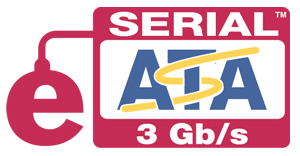External SATA
 External SATA (eSATA) was developed and standardized in 2004 to provide external connectivity for hard disk drives, aimed at the consumer market. eSATA is competing with USB and FireWire external devices, and has several advantages over them. Devices that use USB or FireWire for external connection generally consist of hard disk drives that have standard Parallel ATA or SATA hardware connected to a bridge which translates between both interfaces.
External SATA (eSATA) was developed and standardized in 2004 to provide external connectivity for hard disk drives, aimed at the consumer market. eSATA is competing with USB and FireWire external devices, and has several advantages over them. Devices that use USB or FireWire for external connection generally consist of hard disk drives that have standard Parallel ATA or SATA hardware connected to a bridge which translates between both interfaces.
This can slow performance as the hard drives top data transfer rates can be much higher. Also, some common hard drive features such as S.M.A.R.T. might not work correctly through a USB 2.0 or FireWire connection.
eSATA likely won't replace USB or FireWire for several reasons. USB is very common among OEM PCs and notebooks, as well as being featured on most common motherboards. eSATA is less common but can be easily added to a computer with the installation of an eSATA host bus adapter (HBA) or added to a notebook by use of Cardbus or ExpressCard. eSATA does not have the capability of powering external devices however, which can be done by connecting external devices with a USB adapter (2.5" HDD).





